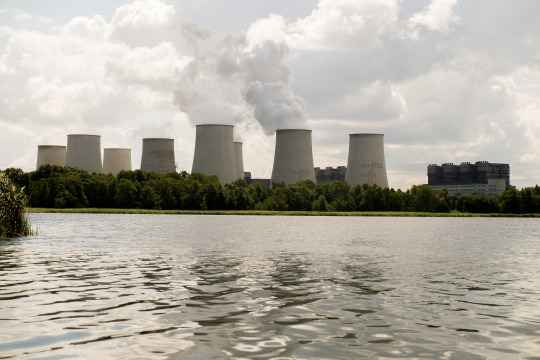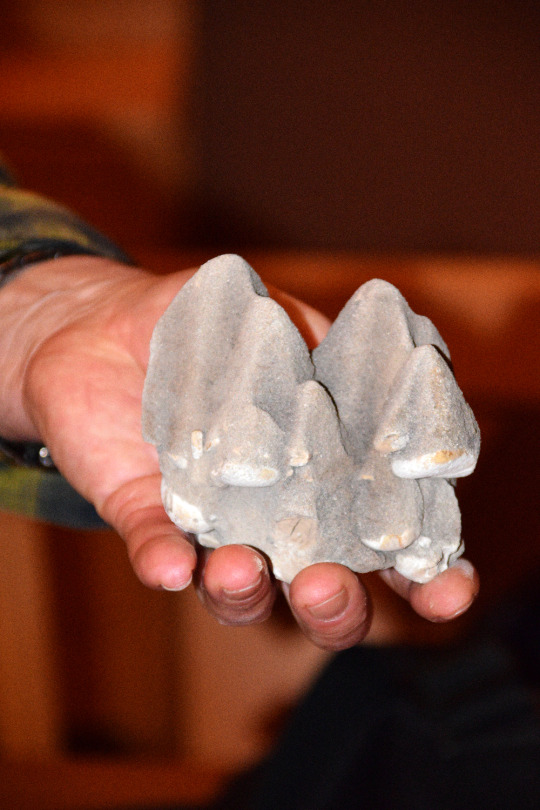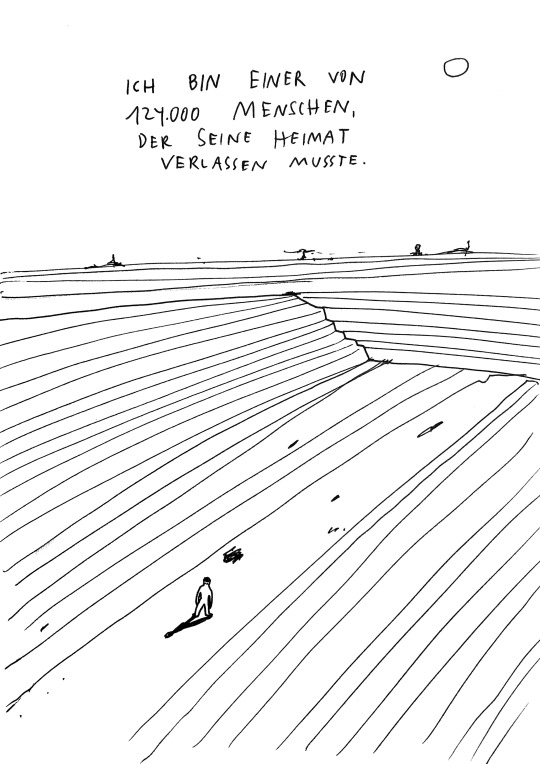#braunkohl
Explore tagged Tumblr posts
Text

Kraftwerk Jänschwalde, Juni 2023
53 notes
·
View notes
Text
Hier könnte die Geschichte zu Ende sein: Ein Landwirt experimentiert, findet eine Lösung und haucht kaputten Böden neues Leben ein. Doch ganz so einfach ist die Sache nicht. Naturschutz und Wissenschaft kommen ins Spiel – und staatliche Vorschriften. Da sich daran aber vermutlich so schnell nichts ändert, müssen die Lausitz-Landwirte auf andere Pflanzen ausweichen. Weiden und Pappeln, zum Beispiel. „Da gibt es vielversprechende Züchtungen“, sagt Böhm.
5 notes
·
View notes
Text

Kegel-Quarzite
Fundstück an Kegel-Quarzit aus einem Rheinischen Braunkohlentagebau Indem.
Aufgenommen bei einem Vortrag in der Niederlausitz über die Fossilien in der tertiären Braunkohle des Miozäns.
#Kegel#Quarzit#Braunkohle#Miozän#Tertiär#Erdzeitalter#minerals#niederlausitz#lower lusatia#east germany#nature pictures#quartz#vortrag#wissenschaft#geologie
2 notes
·
View notes
Text
Derzeit befindet sich das Zeug in den Flüssen, insbesondere der Spree, und beeinträchtigt die Nutzbarkeit als Trinkwasser. "In der Lausitz" ist MAN™ zwar GEGEN die Beendigung des Braunkohlenabbaus vor 2038 (UNSERE™ Arbeitsplätze !). Den Müll würde man aber schon gerne weiter mit dem Flußwasser der Spree entsorgen lassen. Das allerdings wird sich mit dem Ende des Tagebaues auf 1/3 seines bisherigen Umfanges reduzieren. Die anderen 2/3 sind nämlich Grubenwasser aus den Tagebauen.
2 notes
·
View notes
Text

3 notes
·
View notes
Text
Effizient heizen mit Braunkohle briketts – Gussmagg GmbH
Die Gussmagg GmbH bietet Premium-Braunkohlebriketts für zuverlässiges und langlebiges Heizen. Unsere Briketts eignen sich perfekt für Öfen und Kamine und sorgen für eine gleichmäßige Wärmeabgabe bei minimaler Ascheproduktion. Braunkohlebriketts eignen sich ideal für Privathaushalte und Unternehmen und sind eine kostengünstige und effiziente Brennstoffwahl. Mit der Verfügbarkeit in ganz Österreich, einschließlich der Steiermark und dem Burgenland, sorgt die Gussmagg GmbH für Qualität und Komfort. Kontaktieren Sie uns noch heute für weitere Informationen und wettbewerbsfähige Preise für Braunkohlebriketts, die auf Ihren Heizbedarf zugeschnitten sind. Visit: Braunkohle briketts

1 note
·
View note
Text
Fahrt nach Hause mit einem kleinen Umweg nach Sindorf ins Vogelruther Feld, einem Wohngebiet, in das in den letzten Jahren ein paar tausend Menschen gezogen sind, häufig in neue und zum Teil selbst gebaute Häuser. So wie die Eltern meiner Schwiegertochter, bei denen ich etwas abzugeben hatte. Ich fuhr also von meiner Arbeit aus an meinem eigenen Haus in Horrem vorbei und am Schluss auf der K39n an Sindorf vorbei. Dann kam mir in den Sinn, dass es zur Straße, in der meine Mit-Schwiegereltern wohnen, einen kleinen versteckten Zugang und eine Rampe für Räder oder Rollis gibt. Ich fand die Zufahrt und fotografierte sie dann von der anderen Seite. Als ich diesen Text schreibe, fällt mir auf, dass ich wie selbstverständlich Ortsnamen und Begriffe verwende, die Ortsunkundige eigentlich gar nicht kennen und einordnen können. Deswegen ein paar Worte zu den Orten und der Gegend, in der ich lebe. Horrem und Sindorf sind Stadtteile der Kolpingstadt Kerpen, einer Stadt von etwa 70.000 Einwohnern s��dwestlich von Köln. Mein Haus steht 20 km vom Kölner Dom entfernt in Kerpen Horrem. Kerpen selber gehört zum Rhein-Erft-Kreis. Und das alles liegt in einer Gegend, die Kölner Bucht oder auch Jülicher Börde genannt wird. Die Bördelandschaft hier ist geprägt von der Braunkohle und fruchtbaren Ackerflächen und Feldern. Die Förderung der Braunkohle und die ausgeprägte Landwirtschaft haben dazu geführt, dass die Gegend durchzogen ist von asphaltierten Wegen durch die Landschaft. Und das bedeutet wiederum, dass man hier fantastisch Radfahren kann. Das ermöglicht mir, von meinen wunderschönen Erlebnissen auf dem Rad hier zu erzählen. Bördelandschaft, Äcker und Braunkohlekraftwerke Die Jülicher Börde wird im Süden durch die zunehmend hügeliger werdende Eifel begrenzt, im Norden durch den Rhein. Dazwischen zieht sie sich letztendlich von Köln bis fast nach Aachen und Mönchengladbach. Die Landschaft ist in Veränderung, denn die Tagebaue Inden, Garzweiler und Hambach werden sich in den nächsten Jahrzehnten in Seen verwandeln. Die Förderung und Verbrennung der Braunkohle wird 2030 eingestellt. Ich glaube, so richtig kann sich das noch niemand vorstellen. Seitdem ich hier wohne, das sind knapp 30 Jahre, beherrscht die Zuckerrübe die Landwirtschaft. Aber auch das ändert sich. Mais, Raps, Sonnenblumen, Kartoffeln und andere Feldfrüchte nehmen immer mehr Raum und Fläche ein. Mein Eindruck: Es verändert sich alles zum Guten. Es wird vielfältiger, bunter, interessanter, abwechslungsreicher. Ich mag es immer mehr hier. Ich erschließe mir das alles auf dem Rad und damit unmittelbar. Ich erleb die Veränderungen direkt Auch das ist, WARUMICHRADFAHRE.
0 notes
Text
gegen den schmerz und für einen angemessenen und konstruktiven raum für die wut über zerstörung: der linken in leipzig beitreten, nach pödelwitz ziehen. = beides gute lernräume!!
#braunkohle#and what the fuck does this all have to do with becoming a therapist emma?????? besides getting money somewhere???#i still do wanna know what makes people feel good about themselves and the world and also what might be missing in common approaches
1 note
·
View note
Text



'Decarbonization Endgame - #2 Zombie Apocalypse 2024’ Digital Collage, 125 x 125 mm, 2024 Fine Art Pigment Print under Acrylic Glass
'Decarbonization Endgame - #1 Darth Coal’ Digital Collage, 125 x 125 mm, 2024 Fine Art Pigment Print under Acrylic Glass
'Decarbonization Endgame - #3 Count Saxo’ Digital Collage, 125 x 125 mm, 2024 Fine Art Pigment Print under Acrylic Glass
The final battle of decarbonization is being fought in Saxony. In the course of efforts to achieve self-sufficiency since the 1920s, the Sorbian settlement area was massively changed and indigenous culture and language were eradicated by the excavation of villages. In the GDR, this process was intensified because the massive expansion of power plants meant that thousands of people were settled to operate these plants. Although it had been clear since the early 1980s (through the environmental movements) that there must also be a transformation from fossil fuels to sustainable energy production in the former GDR, the need for this after reunification was deliberately concealed and slowed down by politicians. Germany has been a pioneer in green technologies since the 1980s. Conservative politics and large industrial interests have prevented a social, ecological and economic transformation under the guise of job security and are still doing so.
The election results of 2024 compared to 2019 prove the success of reactionary strategies of sacrificing climate and the environment for profit. Despite the progressive energy policy of the current federal government in the global crisis and the availability of sustainable energy production, energy prices are rising while fossil energy companies are making surpluses. Disinformation campaigns financed by the advocates of the fossil world and a populist Saxon state policy are bearing fruit - even with the risk that fascist parties will take power in Germany - just to be able to operate a fossil business model for as long as possible. These campaigns are now so successful that even young people who will experience the destruction of the planet are also voting for right-wing politics. Those responsible for this catastrophic development in politics and the economy can be named and are not hiding.
Our global competitors such as China and the USA are now benefiting from the green technologies developed in Germany. The massive shift to the right and the fascistization in East Germany and the associated hatred of green, but left-wing politics in particular are the politically desired result. Saxony in particular is thus becoming the epicenter of this culture war of old white men who are burning the world. The Prime Minister of Saxony is doing everything he can to discredit the Green partners in the coalition and the traffic light coalition and is providing populist arguments for the right-wing spectrum in a transparent manner in order to stop the long overdue transformation of the entire region. This is particularly effective in the Lusatian lignite mining area, as there is a will for a sustainable transformation in the Central German lignite mining area through the chemical industry based there, which has recognized the advantages of a less fossil-based world from a purely economic perspective.
#sb2130#NSK#NeueSorbischeKunst#Neue SlowenischeKunst#NSKStateLipsk#NSKFolkArt#decarbonization#decolonization#fightfashism#antifashism#montan#mining#lausitzerbraunkohlerevier#boxberg#schwarzepumpe#jänschwalde#senftenberg#lübbenau#welzow#powerplant#LEAG#MIBRAG#braunkohle#lignite#browncoal#fossil#endfossil#LeipzigArtist#Autochthon#SorbianArtist
0 notes
Text

Die Kohle ist ein harter Brocken. Sie gibt den Menschen Arbeit und Wärme und zwingt sie gleichzeitig ihre Häuser zu verlassen. Auch verpestet sie die Atmosphäre mit ihrem schwarzen Rauch. Die große Frage aber ist: Wie werden die Landschaften und unser Leben nach der Kohle aussehen?
Am 1. Dezember 2023 habe ich im Zeitgeschichtlichen Forum in Leipzig ein Panel der Tagung: „Verschwundene und verschwindende Orte. Folgen der Braunkohleförderung in Ostdeutschland" moderiert. Es wurde emotional diskutiert. An der Kohle hängen ganze Lebensentwürfe.
Zeichnung: Tiziana Beck
1 note
·
View note
Text

Kraftwerk Jänschwalde, Juni 2023
17 notes
·
View notes
Text
Der schäfer strickte
lebensbäume in brautstrümpfe
schickte dreizehnjährige weihnachtssängerinnen
mit schlüssel zepter und erlöserpuppe
von ort zu ort
dann sah er bulldozer kommen
sah wie sie die orte zusammenschoben
und wegkarrten schließlich
wurde des teufels geschenk ausgegraben
schwarz die landschaft wurde schwarz
grube reihte sich an grube später restloch
an restloch jedes heißt see
für jeden ort wurde ein stein aufgestellt
auf der planen fläche die sich ums grün müht
immer noch sang er die lieder der weihnacht
in seiner sprache im traum sah er die mädchen
gänzlich verhüllt in gestickten schleifen jedes
nannte sich DAS KIND und ging zu den kindern
des ortes diese zu streicheln die erwachsenen
mit der rute zu streifen damit sie erkennen
was sie da tun
danach war der tag einen hühnerschritt länger
als er ging zog er das jahr nach
die mädchen zogen von hier nach dort
zu pfingsten hatten sie die sprache gewechselt
verloren schlüssel zepter und erlöserpuppe
später kamen sie manchmal auf den pfaden
zum see sahen elch und esel dort äsen
in solarbetriebenen katamaranen fuhren sie
von see zu see als ob sie was suchten
doch die weihnacht behielt das geheimnis
der sängerinnen die art die kinder zu streicheln
behielt das bild der orte den pfad zum schäfer
der lebensbäume in brautstrümpfe strickte
für den nächsten tag einen hühnerschritt länger
- RÓŽA DOMAŠCYNA
0 notes
Text
Entdeckungstour in der ältesten Brikettfabrik Louise

Die Lausitz ist Braunkohlenrevier. Seit über 100 Jahren wird hier Kohle abgebaut. Das Leben vieler Menschen drehte sich hier um die Kohle. Die Brikettfabrik Louise ist heute Sehenswürdigkeit und erlebbare Technikgeschichte. Ich durfte in der weltweit ältesten Brikettfabrik auf Entdeckungstour gehen. Heute wie damals funktionieren die alten Maschinen noch immer. Klimapolitisch sollte die Kohle als Energieträger ausgedient haben. Doch im Laufe des Ukrainekriegs bekommt die Kohle wohl ein Comeback. Als technisches Denkmal jedoch bleibt die Louise uns wohl hoffentlich weiter erhalten.

Energie ist die Grundlage unseres Wirtschaftens

Für eine lange Zeit waren fossile Brennstoffe der Motor der Wirtschaft. Seit Beginn der industriellen Revolution wurde Kohle, Erdöl und -gas zu verschiedensten Zwecken eingesetzt. Durch diese Stoffe und mit ihnen entwickelte sich auch unsere Technik. In der Brikettfabrik Louise im südbrandenburgischen Domsdorf ist diese stetig verbesserte Entwicklung noch heute zu sehen. Die Fabrik ist heute ein technisches Denkmal und kann offiziell im Rahmen einer Führung besichtigt werden. Dabei werden sogar die alten Maschinen wieder in Bewegung gesetzt. Nach neuesten Erkenntnissen ist die Louise sogar die weltweit älteste Brikettfabrik der Welt und sie könnte immer noch zur Produktion genutzt werden. Die aktuell in der Braunkohleregion der Lausitz lagernden Rohbraunkohleflöze sind noch nicht einmal zu einem Drittel abgebaut oder erschlossen. Aus Klimaschutzgründen ist es richtig, dass die menschliche Gesellschaft aus der Nutzung fossiler Brennstoffe aussteigt. Doch für dieses Ausstiegsszenario sollte man auch Alternativen zur Verfügung haben. Und man sollte sich das Wissen der Generationen vor uns bewahren. Ganz sicher werden wir dieses Wissen noch gebrauchen können. Energie soll immer und überall verfügbar sein. Ausreichend für ein beständiges Wirtschaftswachstum. Dafür baut man mehr und mehr Windkraftanlagen und Sonnenkollektoren. In anderen Ländern setzt man weiterhin auf Atomstrom, obwohl nach Tschernobyl und Fukushima die Risiken ebenso bekannt sind. Ich persönlich möchte keinen Atomstrom. Ich möchte auch keine Windkraftanlagenwälder. Für mich zählt die Einsparung von Energie viel mehr als die immer weitere Produktion neuer Energie. Doch das sind schon wieder Gedanken für einen weiteren Blogbeitrag. Die weltweit älteste Brikettfabrik Louise

Am Standort der Brikettfabrik befand sich die ehemalige Grube Louise. Hier inmitten der Braunkohlereviere der Lausitz wurde bereits in früheren Jahren Braunkohle abgebaut. Schnell stellten die Betreiber fest, dass Briketts einen höheren Effizienzwert haben als die rohe Kohle. Im September 1882 wurde die Brikettfabrik in Betreib genommen. Bereits im Jahr 1883 wurden über 150.000 Hektoliter Rohbraunkohle zu Briketts verarbeitet. In der Anfangszeit pressten zwei Pressen die schwarzen Steine. Ohne Strom, nur allein mit Dampf wurden die ersten schwarzen Steine gepresst. Der ständig steigende Bedarf jedoch machte umfangreiche Erweiterungen nötig. Auch der industrielle Fortschritt wurde genutzt. Zum Schluss wurden sieben Pressen zur Brikettproduktion genutzt. Zu den ursprünglich vorhandenen sechs Tellertrocknern wurden zwei Röhrentrockner aufgebaut. 1896 wurde die erste Lichtmaschine zur Stromerzeugung in Betrieb genommen. Schon bald nach der Inbetriebnahme wurde die Brikettfabrik in die Bergwerksgesellschaft "Eintracht" überführt. 1908 begann der erste Bauabschnitt der Kraftwerkshalle. Weitere Abschnitte folgten in den Jahren 1924 und 1938. Die Tagesleistung der Fabrik betrug im Jahr 1938 360 Tonnen. Bis zum Stillstand der Anlage wurde diese Tagesleistung auf 584 Tonnen erhöht. Trotz der ganzen Erweiterungen der Fabrik ist Louise eine der kleinsten Brikettfabriken in Deutschland geblieben. Seit Beginn der Inbetriebnahme liefen die Anlagen ununterbrochen. Nur beim Einmarsch der Roten Armee im Jahr 1945 zum Ende des Zweiten Weltkrieges kam es wenige Stunden zum Stillstand. Nach dem Krieg wurde sie in Volkseigentum überführt und schliesslich 1968 dem Kombinat Braunkohleveredlung Lauchhammer angegliedert. Am 18. November 1991 wurde das letzte Brikett gepresst. Nach 110 Jahren erfolgte am 6. Februar 1992 die bislang endgültige Stilllegung. Die Fabrik wurde in eine Verwertungsgesellschaft übernommen und sollte komplett abgerissen werden. Glücklicherweise erkannte man aber noch rechtzeitig ihren Wert. Die Brikettfabrik Louise wurde im September 1992 in die Denkmalsliste des Landes Brandenburg aufgenommen. Der Verein Freundeskreis Technisches Denkmal "Louise" e.V. kümmert sich seit September 1994 um den Erhalt der Maschinen und technischen Anlagen. Mit Erfolg, den viele der Maschinen können noch heute produzieren. Aktuell wird untersucht, ob die Brikettfabrik den Anforderungen als UNESCO-Weltkulturerbe entspricht. Technisches Denkmal und Weltkulturerbe Beim Betreten des Werksgeländes wird man entführt in eine Ära, in der Industrie, Kultur, Maschinenbau und Kunst noch eine Einheit waren. Die Gebäude, Räume und Maschinen sind noch im Original erhalten. Bei den Führungen können bis zu 14 Anlagen in Bewegung erlebt werden. Ein Highlight dabei ist die "Dampfzeit", bei der die historische Brikettpresse im Echtdampfbetrieb vorgeführt wird. Nicht nur das mehr als hundertjährige Alter der Brikettfabrik ist interessant. Louise hat durchaus auch noch einige andere Besonderheiten zu bieten. Die noch vorhandenen Pressen sind über die Jahre hinweg in sechs verschiedenen Typen gefertigt. Alle werden aber mit Dampf angetrieben. So sind verschiedene Systeme zur Steuerung des Füllgrades und der Kolbenbewegungen vorhanden. Louise ist auch eine der wenigen Fabriken, die das Tellertrocknungs- und das Röhrentrocknerverfahren angewendet haben. Das Kesselhaus ist mit Flammrohrkesseln ausgerüstet, die um die Jahrhundertwende modern waren. Die notwendige Energieerzeugung ist einfach aufgebaut und enthält trotzdem alle Grundelemente eines modernen Grosskraftwerks. In der Brikettfabrik Louise konnten wir alle Bereiche des Warenflusses in der Fabrik im Rahmen einer 6-stündigen Foto-Tour besichtigen. Dabei konnten wir uns frei bewegen. Aufgrund der Größe der Anlage standen wir uns als Fotografen nicht im Weg. Das ist schon sehr wichtig bei solchen Veranstaltungen. Zu Beginn der Tour sollte es einen kurzen Rundgang geben, in dem die Funktionsweise der Fabrik erklärt wurde. Leider musste diese aus Gründen abgebrochen werden. Das fand ich persönlich sehr schade, da ich auch als Fotograf eigentlich wissen möchte, was ich da fotografiere. Leider merkte man aber auch, dass einige Fotografen nur fotografieren wollten, so dass der Mehrheit der Gruppe die Abkürzung der Tour ziemlich willkommen war. Entdeckungstour in der ältesten Brikettfabrik Louise Rohkohlebunker - Anlieferung der Rohbraunkohle

Hier erfolgte die Anlieferung der Rohbraunkohle per Schiene. In diesem riesigen Gebäude wurde die angelieferte Rohbraunkohle auch von Fremdstoffen wie Steinen, Holz etc. getrennt. Die Kohle wurde ebenfalls gebrochen und zerkleinert, über diverse Siebe geführt und schliesslich über Förderbänder weiter zum Nassdienst transportiert. Nassdienst und Trocknung - Verarbeitung der Kohle

In weiteren Verarbeitungsschritten wurde die Kohle "gewaschen" und in den einzelnen Teller- und Röhrentrocknern getrocknet. Dabei wurde der Wassergehalt der Braunkohle bis auf maximal 20% reduziert. Ein Teil der Kohle wurde zur Wärme- und zur Dampferzeugung verfeuert. Knapp 65% der Kohle wurde damit zur Pressung weiterverarbeitet. Wichtig war die Erzeugung von Dampf zum Betreiben der Maschinen und Anlagen. Gerade zu Beginn der Industrialisierung zeugten diese Anlagen vom Erfindungsreichtum der Maschinenbauer. Pressung - Herstellung der Briketts Während der Verarbeitung wurde die Kohle bis zu einer Korngrösse von 5 Millimetern zerkleinert. Dieses Kohlepulver wurde über die verschiedenen Pressen zu den bekannten Brikettformen zusammengepresst, abgefördert und für den Abtransport und Verkauf vorbereitet.

Kraftwerkshalle - das Herzstück

Gesteuert wurde die ganze Fabrik in der Kraftwerkshalle. Hier hatte man den Überblick! Fabrikgelände Fast alle Gebäude und Anlagen sind noch im Originalzustand erhalten. Die verschiedenen Baustile und -zeiten sind erkennbar. Das ist Industriekultur! Das Ende der Fabrik

Mit der politischen Wende in der DDR, der Wiedervereinigung und der desaströsen Politik der Treuhand wurde auch die Existenz der Brikettfabrik Louise obsolet und wirtschaftlich nicht mehr tragbar. Louise hat diese Zeiten dennoch überlebt und wird nun hoffentlich noch weiteren Generationen als Denkmal und Anschauungsobjekt zur Verfügung stehen. Aufgrund der aktuellen weltweiten Entwicklung, des Kriegs in der Ukraine, der Klimakrise und der damit einhergehenden Energiepolitik ist es vielleicht vorteilhaft, altes Wissen und alte Erfahrungen weiterhin zu bewahren. Sollte sich unser Lebensstil nicht radikal ändern, werden wir alte Technologien immer noch benötigen. Tipps zum Besuch Aktuelle Hinweise zu Veranstaltungen, zu den Öffnungszeiten und vieles mehr erfahrt ihr auf der offiziellen Webseite der Brikettfabrik Louise. Neben der Louise könnte ihr noch andere Relikte aus der Kohlezeit erkunden. Da der Ort Domsdorf nur ein kleiner Ortsteil ist, haben wir unsere Übernachtung im wunderschönen Bad Liebenwerda gebucht. Das Elbe-Elster-Land bietet sich für ausgedehnte Radtouren an. Der Naturpark “Niederlausitzer Heidelandschaft” bietet sich für ausgedehnte Wanderungen und vielfältige Naturerlebnisse an. Man kann also gern ein verlängertes Wochenende in der Region verbringen. Read the full article
1 note
·
View note
Text
Braunkohle kaufen – Gussmagg GmbH
Bei der Gussmagg GmbH finden Sie hochwertige Braunkohle für effiziente Heizlösungen in ganz Österreich. Unsere Braunkohle liefert zuverlässige, lang anhaltende Wärme, ideal für Häuser und Heizsysteme in Regionen wie der Steiermark und dem Burgenland. Kontaktieren Sie uns für aktuelle Preise und um unsere Brennstoffoptionen für erschwingliche, effektive Wärme zu erkunden. Visit: Braunkohle

1 note
·
View note
Text
Nach dem Home-Office schnell noch einmal eine Fahrt auf einer meiner Hausrunden. Über die Wiedenfelder Höhe und dann über den Speedway. Auf der Fahrt dann der Blick übers Feld auf die Kraftwerke in Neurath. Das war mir in dem besonderen Licht des Vorabends dann ein Foto wert. Den Blick kurz nach links gewandt und auf die vielen Windräder an Horizont. Noch ein Fotomotiv. Vielleicht nicht etwas für alle, aber ich finde das schon besonders. Ich bin gerne her an diesen Orten. Die Landschaft ist weit. Und flach. Man zieht Dinge, die weit weg sind. Es ist eine Kulturlandschaft, aber auch eine Naturlandschaft. Hier entsteht Energie zum Leben, auch auf den Feldern, nicht nur in den Kraftwerken. Ich fahre gerne her Rad. RWE und die Landwirtschaft haben viele befestigte Wege durch die Landschaft gebaut. Auf denen kann ich kilometerweit fahren, ohne einem Auto zu begegnen. Zwischen den Tagebauen vor allem geht es ein Wegenetz, das gut ausgebaut ist und auch noch tolle Ein-und Ausblicke vermittelt. So dass auch lange Fahrten interessant und abwechslungsreich bleiben. Einfach nur schön Und nicht zuletzt verändert sich die Landschaft ständig. Auch der erlebbare Wandel hier ist WARUMICHRADFAHRE
0 notes